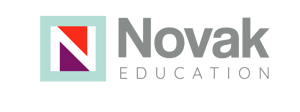I have the great fortune of coming from a family of builders, so I got a lot of experience building as I grew up. I worked summers and school breaks through high school and college with my uncles and later with my brothers - painting, papering, remodeling, and building homes. I’ve gotten pretty handy in the process.
In every building project, you start at the bottom (or base) and work your way up or out. For a house, you build the foundation first and then add floors, walls, and a roof before paint and finish. For a wall, you build a frame before adding a wallboard and then plaster and paint. Building from the bottom up creates a solid foundation and a quality project. However, during this process, we sometimes need help. Sometimes, we need different tools or scaffolding to work on things that are out of our reach, or we need a specialist to do our plumbing or electrical work. This support helps us to build a better end product.
The same goes for learning.
Scaffolding is when various levels of support is provided to help learners achieve higher levels of comprehension and skill acquisition. Traditionally - it is seen as temporary, but scaffolding can also serve as a permanent resource, enhancing proficiency and efficiency in areas where mastery is complemented by supportive tools (ex. spellcheck or Grammarly).
Just as construction scaffolding provides access to areas beyond reach, educational scaffolding offers students access to learning experiences just beyond their current level of mastery. And just like in construction, not all scaffolds are the same (learn more about scaffolding tune in to Episode 26 of The Education Table Podcast with Katie Novak). In teaching, we use three main types of scaffolds to support student growth:
- Linguistic scaffolds support students who may struggle with language barriers or need help processing verbal or written information (ex. sentence starters, multimodal instruction like verbal instructions with visual supports, and access to tools like text-to-speech to support understanding of or expression of language).
- Conceptual scaffolds help students understand complex ideas by breaking them down into manageable parts (ex. modeling, explicit instruction, graphic organizers, rubrics, and exemplars).
- Socio-cultural scaffolds build on the power of collaboration and community to support learning (ex. small group instruction, peer review, discussion protocols, and self-assessment tools that prompt students to reflect
While traditional views on scaffolding emphasize its temporary nature, aimed at gradually reducing support as the student becomes more proficient, we also recognize that some forms of scaffolding may remain valuable throughout a learner's journey (Ex. many of us continue to rely on tools like spellcheck). This broader perspective acknowledges scaffolds not only bridge gaps during learning but can also become tools of empowerment, helping students develop learner agency.
As teachers, we can become architects of learning so that all students can achieve high levels of mastery. We know that every student is different and has their own set of skills and attributes as well as their own barriers to learning. As good craftspeople, we can support student learning by providing students with multiple opportunities to learn and share what they know, as well as strategies, tools, and supports to help them build their knowledge and skill set.
Scaffolding, rooted in educational theories like Vygotsky's Zone of Proximal Development, takes on a new dimension through the lens of Universal Design for Learning (UDL). In universally designed classrooms, we encourage students to analyze firm goals and then self-reflect on their learning so they can choose pathways that best accelerate their growth. This approach often includes the strategic use of linguistic, conceptual, and socio-cultural scaffolds to empower students to take ownership of their learning.
6 Ways to Scaffold Instruction
Scaffolding in education can be provided in multiple ways. We can:
- Provide a low-stakes diagnostic assessment to help students determine their access point. Then, allow them to determine what they need to move forward. For example, ask them to reflect on the following questions:
- Where do I feel confident, and where do I need more support?
- Based on my current understanding, what resources or strategies will best support my learning and help me grow?
- Invite students to identify and pursue learning paths that resonate with their strengths, interests, and future goals. This strategy fosters engagement and allows students to personalize their learning by choosing the strategies and materials they need to feel challenged and supported. Be sure to ask students to reflect often on whether their choices support their learning journey.
- Offer students a variety of ways to engage with grade-level materials, including digital platforms, hands-on activities, and creative arts, encouraging them to select the formats that best suit their learning preferences without lowering the rigor of the standard. This is similar to choosing the right scaffolding or tool for a job, with students taking the lead on which strategies and tools will help them work toward grade-level mastery.
- Rather than prescribing specific resources, provide a toolbox of options for students to choose from, including graphic organizers, visual aids, choice boards, examples, vocabulary, and/or different ways of working with the content. This could include working individually, with a partner or a group, or interacting with the content through paper, technology, or a different medium.
- Provide different ways for students to show us what they have learned (multiple means of action and expression) that align with grade-level standards so they are graded in “construct relevant” ways. Consider how you can share firm goals with students, success criteria, and numerous tools, and then ask students to reflect on the question, “How can I incorporate my interests or passions into demonstrating my learning while still meeting the educational standards and success criteria?”
- Offer targeted feedback focusing on mastery and improvement, followed by opportunities to refine and enhance their work. This practice supports growth and high levels of learning, similar to the iterative process in construction, where feedback and revisions are integral to achieving success.
With these scaffolds in mind, we can create a personalized, student-centered learning environment that respects individual differences and empowers students to take charge of their learning, fostering deeper engagement and understanding.
Continue Your Learning! Explore how to effectively instruct a diverse group of learners.
This post has been updated from it's original publishing date of March 2024.



